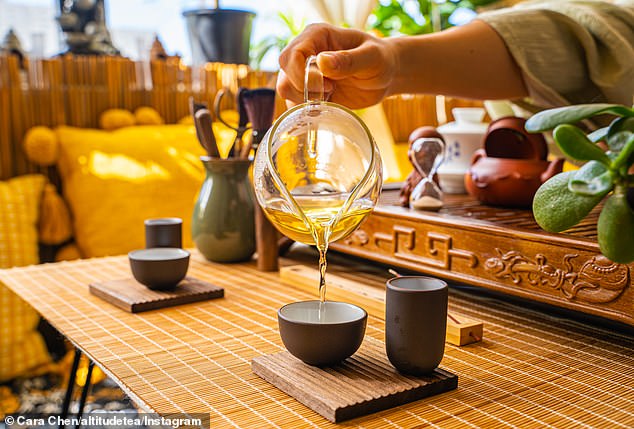Are you making tea wrong? Australians rediscover ‘correct’ way to brew tea using forgotten ancient tradition
Australian tea lovers have discovered a ‘forgotten’ tradition dating back centuries – and the spiritual act has a practical reason.
A New South Wales resident discovered the “correct way” to make tea by turning the teapot three times clockwise and three times counterclockwise after pouring boiling water into it.
“My family has never done this, but I’ve heard from a few people that it’s tradition. The reasons I’ve been given are ‘for luck,’ ‘to settle the leaves,’ and ‘to make the brew stronger,'” she shared on Reddit.
She wondered if it was a “real” Australian tradition or just a “generational joke to get people to do something silly and unnecessary” – but the act goes back centuries.
Tea expert Cara Chen told FEMAIL at a Gongfu tea ceremony that pouring the kettle counterclockwise instead of clockwise is rooted in traditional Chinese philosophy, which emphasizes the natural flow of energy (Qi) and promotes harmony is promoted.
Tea expert Cara Chen told FEMAIL at a Gongfu tea ceremony that pouring the kettle counterclockwise instead of clockwise is rooted in traditional Chinese philosophy
In addition to the benefits of the Gongfu ceremony, spinning a teapot also works to agitate the water by introducing a circular flow that mixes the tea leaves and prevents them from clumping.
When you then turn the teapot the other way, you go against the flow and allow the water to settle again, which prevents the tea from marinating too much.
“This practice symbolizes positive, harmonious energy and aligns with the natural order,” Ms. Chen added.
‘Moreover, it preserves the authenticity and traditions passed down from generation to generation, and sometimes the design of tea sets and seating arrangements makes the counterclockwise movement more practical and ergonomic.
‘Hospitality is an important aspect of the tea ceremony, and pouring counterclockwise is a welcoming hand gesture, enhancing the sense of warmth and invitation for guests.’
A few Australians also explained a Billy Tea ceremony.
‘It is traditional to wave Billy tea – made over an open fire – in a circle three times to allow the leaves to settle.
By ‘circle’ I mean vertically with your arm extended, from your knees to above your head and back. You have to do it quickly enough so that the water doesn’t spill.’

Spinning a teapot works to agitate the water by introducing a circular flow that mixes tea leaves together and prevents them from clumping
People were overjoyed that such traditions developed into turning teapots in the household kitchen.
‘The Billy Spin is definitely an Australian tea tradition. It’s a move that makes more sense to me when it comes to letting the leaves settle. Moreover, it is more theatrical. Interesting thought that turning the teapot might be a more kitchen-friendly version of this campfire tradition!’ said one.
Many from Britain revealed that ‘turning the teapot’ was an essential step in making English tea.
“I only learned this when I moved to Britain,” said one Australian. ‘A gentleman I was working with patiently explained how to make the perfect English tea (both for customer presentation and taste), and it was an eye-opener.
‘Now I’m back in Australia, but when I have fancy guests around I always make a point of spinning the teapot three times. I can never remember which direction, and no one ever picked me up.”
Another added: ‘I have no idea what settling the tea leaves does, but turning the teapot three times in each direction is a must unless you want weak tea. You can easily see that if you steep it and then pour it, the tea is weak. Turn it and it’s strong. You mainly have to make do with the rubbish tea bags you get in cafes.’
